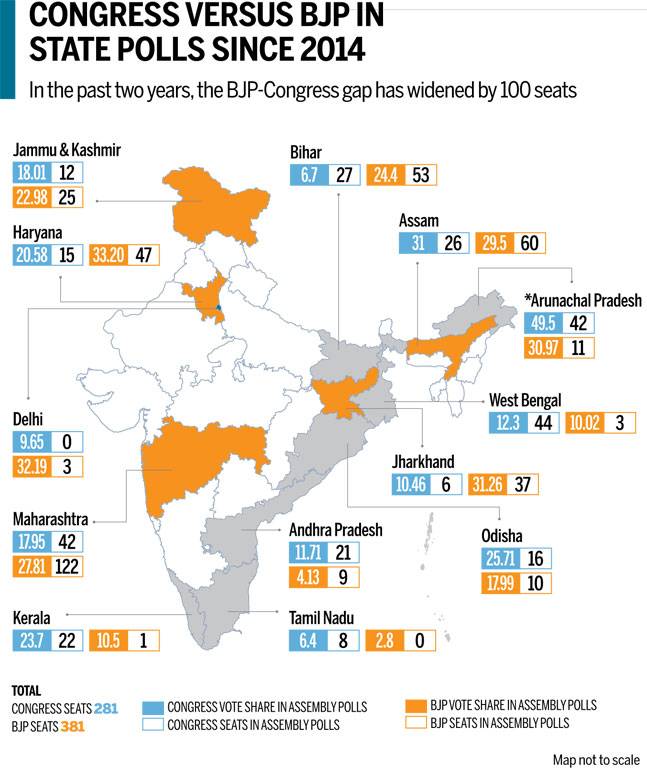Indian National Congress
This is a collection of articles archived for the excellence of their content. |
Manifestoes
2019
Rahul Offers Liberal Dose Of Jobs & Sops, April 3, 2019: The Times of India
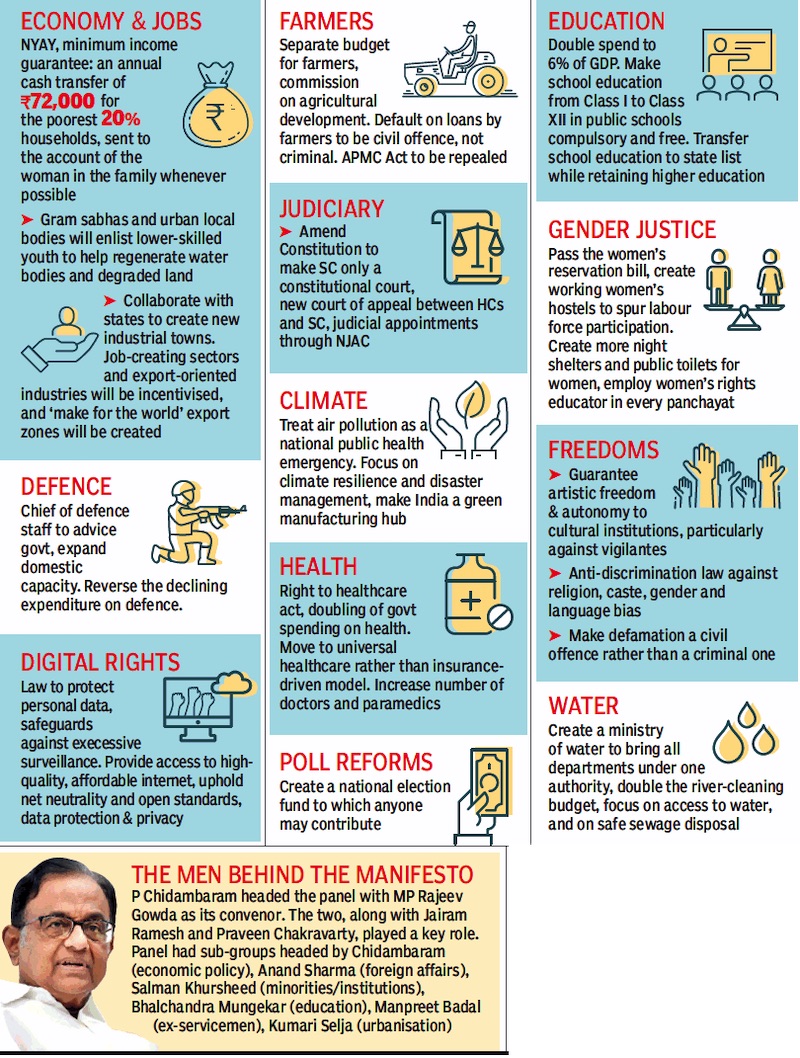
From: April 3, 2019: The Times of India

From: April 3, 2019: The Times of India
Promises Ministry Of Employment & 1 cr Jobs In Villages
Congress has promised to set up a new ministry of industry, services and employment, fill up four lakh vacancies in the government, public sector undertakings and judiciary and work with state governments to create 10 lakh new “seva mitra” positions as part of its strategy to create jobs.
“In the last five years, there has been a dramatic rise in unemployment. Today, unemployment is touching a 45-year high of 6.1% according to the government’s own figures. The Centre for Monitoring Indian Economy puts the number at 7.2%. At the end of this February, 3.1 crore people were actively looking for jobs,” Congress said in its manifesto and promised a string of measures to boost employment, which is one of the key election promises of the party.
The issue of jobs has come under the election spotlight as the opposition and the government have exchanged barbs over employment. The opposition has accused the government of withholding data on jobs while the Centre has said that an expanding economy has created a huge number of jobs.
Congress said it would launch two major programmes to be implemented through gram sabhas and urban local bodies that will create 1 crore jobs and this will be through repair and restoration of water bodies and regeneration of wasteland.
As a condition for devolution of funds to the healthcare and education sectors and to panchayats and municipalities, the manifesto said it would request state governments to fill all vacancies, estimated at 20 lakh, in the two sectors and in local bodies.
The party also promised regulatory forbearance for micro and small enterprises and said they would be exempt from all applicable laws and regulations (except the Minimum Wages Act and tax laws) for a period of three years from April 1, 2019 or, in the case of new businesses, the date of commencement of business.
Congress said it would reward export oriented industries through tax rebates and incentives and promised an adequately capitalised tourism development bank to provide low-cost, longterm funds for investment in tourism-related businesses.
YEAR-WISE HISTORY
1918: Special Session in Bombay
The Indian National Congress. (From an Editorial)
The Indian National Congress meets to-day [August 29] in the Special Session in Bombay in circumstances of exceptional gravity. It has been convened by the Congress executive, the All-India Congress Committee, to consider the proposals of Indian constitutional reform made by Mr. Montagu, and Lord Chelmsford, and to express the collective opinion of educated India on the Report which has been published. It was the Congress that more than a year-and-a-half ago put forward, in conjunction with the premier national organisation of the Moslem community, a scheme of reforms which has captured the imagination of the people and forced the Government to bestow serious and earnest attention to the problem of political advance in this country. The joint scheme was justly claimed to be the minimum that was essential to render the government in India answerable to the people and place them on the road to self-government.
It is right and proper, therefore, that the Congress should examine how far the alternative plan suggested by the Secretary of State and the Viceroy corresponds to its own scheme and to what extent it would, if carried out, remedy the existing administrative evils and facilitate the march towards the goal. What the Cabinet now desires is consideration and criticism of the proposals and the obvious task of the Congress is to bring to bear on that great question the collective wisdom and mature judgment of the leaders of Indian thought and declare in unequivocal language what the country thinks of the scheme and how far it answers the expectations and satisfies the aspirations of the people.
Breakaways: parties that emerged from the Congress
1947-2019
February 12, 2020: The Times of India

From:February 12, 2020: The Times of India

From: February 12, 2020: The Times of India

From: February 12, 2020: The Times of India

From: February 12, 2020: The Times of India
See graphics:
Major Congress breakaways over the years, 1951- 1981
Major Congress breakaways over the years, 1994- 2011
In 2014, Trinamool was the most successful breakaway, 2014
Total votes polled for party, Percentage of votes polled in seats contested, Percentage of votes votes polled in states contested, 2014
Congress, which has its roots in India’s freedom struggle, has been around for more than a century. It’s seen every change in modern India’s political landscape and has itself been through several transformations. Interestingly, it also appears to be the nursery for other political parties, spawning no less than 70 parties since independence.
Most of the breakaway parties though are either defunct or have merged with other parties and a majority of the remaining existing parties don’t show much strength in the Lok Sabha polls. But there are three that are really active in Lok Sabha elections — Trinamool, NCP & YSR Congress.
CONGRESS BREAKAWAYS WON MORE SEATS THAN PARENT PARTY IN 2014
Nehru-Gandhi dominance over Congress, 1919-2017

From December 16, 2017: The Times of India
See graphic:
Nehru-Gandhi dominance over Congress, 1919-2017
1969: Syndicate vs. ‘Indicate’
President Pranab Mukherjee reopened the pages of history by suggesting that Indira Gandhi saw through a plot hatched by Congress veterans, known as the “syndicate“, to dilute the Prime Minister's powers by installing a young Sanjiva Reddy in Rashtrapati Bhavan.
He also touched upon momentous events of Indira's life including Emergency , and referred to a survey to call her the best PM against whom the future premiers would be assessed. Touching upon the 1969 presidential election that came amid a confrontation between Indira Gandhi and senior Congress leaders who sponsored Reddy , Mukherjee said Indira sided with V V Giri, who had jumped into the fray , leading to Reddy's defeat. He wondered why a young and successful Reddy wanted to occupy an office without executive powers.
“Was Reddy's nomination an effort to curtail the powers of PM? Did Indira's rivals want to use the constitutional office of the Presi dent to provoke a confrontation between the President and the PM? Perhaps, Indira opposed Reddy's candidature because she saw through this game.She saw that an attempt was being ma de to dilute the authority of the PM and to enhance the role of the President,“ he said, delivering the Indira centennial lecture organized by Congress at Vigyan Bhavan.
Mukherjee linked the 42nd amendment to the Constitution, binding the President to the advice of the Cabinet, to this experience.
After the 1977 Lok Sabha defeat
Mukherjee said following the 1977 Lok Sabha defeat, Indira refu sed the advice of ma ny party leaders that cooperation with Ja nata Party was must to earn a popular par don for Emergency .
He recalled, “The atmosphere following e the elections was ex tremely hostile for In dira. The Janata Party as well as a section of Congressmen conducted a relentless slander campaign against her. The media was also completely against her. Anti-Indira rallies were held across the country with demonstrators shouting `hang her'.“
The President said the then home minister declared that Indira Gandhi's `crimes' deserved a trial on the lines of Nuremberg. “Frivolous cases were instituted against her and in one instance, she was even made co-accused in a case of stealing eggs and chicken in Manipur,“ he said.
1984: Mrs Gandhi has premonition about her death
The Times of India, Oct 20 2015

`Scindia lobbied Amar Singh against backing Cong bid to form govt in 1999'
Indira Gandhi had a premonition about her death just days before she was assassinated and con fided to her close associate M L Fotedar that she saw the possibility of Priyanka Gandhi eme rging as her political legatee over time -a suggestion that did not seem to go down well with Sonia Gandhi.
Revealing the dramatic circumstances of Indira's last days, Fotedar said she had visited Kashmir in late October 1984, drawn by a fondness of the change of season scenery and a desire to visit a Hindu and a Muslim shrine that the late leader reposed particular faith in. She was assassinated in Delhi on October 31, 1984. The old time Gandhi loy alist's recollection are due to be made pub lic soon in the form of a book `Chinar Leaves' that will be released on October 30 in the capital. Fotedar seems to support former minister Natwar Singh's claim that family pressure rather than an “inner voice“ was the reason for Sonia declining the prime minister's post in 2004.
“She saw a sign at the Hindu shrine that made her feel that her life was coming to an end. On the way back to the rest house in a car, she said as much. Then, in a thoughtful mood, she said Priyanka might be cut out for politics...that she might be successful and be in power for a long time,“ Fotedar.
The “sign“ Indira saw and which she interpreted to mean impending death was a shriveled tree at the Hindu shrine. Fotedar said he too read a similar portent. “I think she realised that I had noticed it too and reached similar conclusions. She revealed her mind on the way to the rest house,“ Fotedar said.
Much later, Fotedar wrote a detailed letter to Sonia putting down Indira's thoughts on Priyanka after the assassination of Rajiv Gandhi in 1991 during campaigning for the Lok Sabha election. Apparently , the contents of the letter were not well received.“I did write to Sonia describing whatever transpired on hat visit to Kashmir,“ Fote dar said.
1996: Sitaram Kesri
His caste
Congress Party Picks Low-Caste Leader, September 24, 1996: Los Angeles Times
The Congress (I) Party, which ran India for much of its independence only to lose power in 1996, chose Sitaram Kesri, a low-caste confidant of the former prime minister, as its temporary president. Former Prime Minister P. V. Narasimha Rao resigned the party leadership after a judge ordered that he be charged with corruption. Kesri is a respected leader of low-caste Hindus in northern India. He has been party treasurer for the last 20 years. His leadership could swing low-caste votes toward the party in upcoming state elections in Uttar Pradesh, India's most populous state.
Party leader Tariq Anwar, who was Kesri’s political advisor, came forth to declare that the former party chief was not a Dalit. he belonged to ‘Vaishya’ community.
The Congress leader also claimed, “Kesari Ji himself offered to resign from the post of Congress president if Sonia ji was ready to take over. At that time I was Sitaram Kesari’s political advisor, so I’m aware of it,” he claimed.
Prime Minister Narendra Modi declared that the Congress did not let its former ‘Dalit’ leader complete his term as president.
“The country knows that Sitaram Kesri, a Dalit, was not allowed to complete his five-year term as Congress president. He was thrown out of office and to the footpath to make way for Sonia Gandhi as the new party chief,” Modi declared.
The Congress rubbished the prime minister’s claim of Kesri being a Dalit, claiming instead that the leader belonged to the Vaishya or Bania community.
Modi had used Kesri’s reference to claim how only four generations of the Nehru-Gandhi family “benefitted from being in power” even as he tried to impress upon the gathering that the family would not have any ‘outsider’ lead the party. He further challenged the Congress to have someone “capable” from outside the “family” to be its president.
“Remember the days when four generations of a family ruled the country. What was the fate of the people? They only thought about the welfare of one family but never thought about the welfare of the people. How can we expect them to fulfil the aspirations of the people now?” he asked.
Speaking on the last day of campaigning for the second round of assembly elections in Chhattisgarh, Modi also accused the Congress of placing many hurdles in the path of chief minister Raman Singh. “For 10 years, the Centre was ruled by a remote-control government, which never paid attention towards Chhattisgarh,” he said.
He also accused Congress president Rahul Gandhi of playing a game of promises over its proposed farm loan waiver scheme. Averring to the issue, which has caught the fancy of the electorate, Modi said: “As elections approach, the Congress plays a game of promises. But they cannot mislead the country anymore. They must answer what they did for the welfare of our farmers when they ruled for four generations.”
Within minutes of Modi’s claim on Kesri, the Congress called his bluff. Party leader Tariq Anwar, who was Kesri’s political advisor, came forth to declare that the former party chief was not a Dalit. “PM is again wrong as Kesari ji was not a Dalit, he belonged to ‘Vaishya’ community.”
The Congress leader also claimed that Modi was also wrong on the fact that Kesri had been removed. “Kesari Ji himself offered to resign from the post of Congress president if Sonia ji was ready to take over. At that time I was Sitaram Kesari’s political advisor, so I’m aware of it,” he claimed.
Congress spokesperson Manish Tiwari had a slightly different take on Kesri’s background. He tweeted that “Kesri was a Bania OBC from Bihar and not a Dalit. However, when has the PM allowed facts or truth to stand in the way?”
While Modi erred on Kesri’s caste, the fact remains that towards his last days in office, Congress did not show Kesri the respect he deserved as head of the party. He was not even invited for a major party rally at Nuh in the Mewat district of Haryana that was attended, among others, by the then senior leaders Manmohan Singh, Ghulam Nabi Azad and Natwar Singh. Kesri resigned as party president in March 1998 after Congress lost the Lok Sabha elections.
1998- 2017: The Sonia Gandhi years
Subodh Ghildiyal, December 17, 2017: The Times of India
See graphic:
1998- 2017- The Sonia Gandhi era of the Congress

From: Subodh Ghildiyal, December 17, 2017: The Times of India
The Sonia years: The rise to glory, and then the fall
Assessing her 19 years at the helm of Congress, which “was like a lifetime had flown by”, Sonia Gandhi said she took charge when the party was faced with a crisis, with governments in barely three states and power at the Centre nowhere in sight.
Contrasting Congress’s barren patch with the later spell under her leadership, Sonia said the party went on to form governments in over two dozen states and ruled the Centre for two consecutive terms. The Congress supremo’s emotional speech, as she vacated the chair for son Rahul Gandhi, best summed up what will be known in political history as “The Sonia years”.
A reluctant politician forced into office by Congress leaders who found the party adrift in the post-Rajiv Gandhi vacuum, Sonia united a splintering Congress and made it the byword for power for a decade. How it was achieved and sustained marked a paradigm shift in the frozen mindsets of an institutionalised Congress.
For Congressmen, Sonia would always be known for how she stitched a strategy to vanquish Atal Bihari Vajpayee’s BJP at the peak of its appeal in 2004.
Her enduring achievement was her imaginative strategy to propel Congress into the “coalition age”. With an entrenched belief that it was the “natural party of governance” and others were “vipaksh”, Congress managers refused to look at how a federalising polity had made “oneparty rule” redundant in the post-Mandal-Mandir phase.
Congress waited for coalitions to collapse, like V P Singh’s, or brought governments down, like that of Chandrashekhar, but did not think of sharing power.
On the other hand, rival BJP stole a march as its awareness of its geographical limitations forced it to cobble together an alliance that managed to capture power in Delhi. BJP’s success possibly delivered the message home, and Congress erected the rival “secular bloc” under Sonia in 2004. It struck gold and, defying doomsayers, UPA came to power and ruled for two terms under Manmohan Singh.
As Sonia left office, Congress leaders pointed to the “UPA coalition” as her biggest achievement. Targeted by the R-S-S family, Indira Gandhi’s daughter-in-law manoeuvred smartly to defuse the “foreign origin” bomb by naming an accomplished economist without a personal political constituency as the PM.
In an unheard of system, UPA ruled as a diarchy with Sonia heading an advisory body called National Advisory Council and Manmohan Singh helming the government. The system did well, coopted activism and branded Congress “pro-poor”. Sonia was the toast of the commentariat and Congressmen.
But Sonia’s success had an expiry date. The system of governance broke down in UPA-II because of clashes of ideas and compulsions of coalition, partially known as corruption. That the party which enacted the Right to Information and sacked leaders for graft became so hated that a newbie in AAP could supplant it in Delhi, reflected how deep the rot ran and how serious the crisis of perception was.
Sonia failed to detect the drift in government which chipped away at the otherwise unshakeable Congress, a fact that lies at the root of the party’s decimation in 2014 and is lamented as her big failure. Many wonder how her famed reflexes failed to notice the incoming disaster. She also fumbled in political succession. Whenthe successor was no secret and her own interest was waning, the change of baton could have been better timed, possibly when Congress was still strong.
Instead, Rahul’s entry into Congress and his “new ideas” created a parallel subset in the party, the cause of schisms along “generational” and “transparency” lines. The “insider-outsider” debate took a toll on Congress.
And what followed as a result was the big defeat in 2014 from which Congress has not recovered three years into the opposition. Like her entry, Sonia’s exit coincides with an existential crisis facing Congress. Can the son match the mother’s record, that was the question uppermost on all minds as the batonchanged hands.
1999: Scindia lobbied Amar against backing Cong’s govt. bid
The Times of India Fotedar said the late Madhavrao Scindia lobbied former Samajwadi Party eader Amar Singh against supporting the Congress's claim to forming a govern ment in 1999 after the Vaj payee government lost a con idence motion by one vote Scindia, according to Fote dar, was miffed at the possi bility of Sonia nominating Manmohan Singh as the prime minister and worked to prevent such an eventuality . While Fotedar's account has the Manmohan Singh angle, the accounts of the period have Sonia as having made the claim to have the support of 272 MPs to the then President K R Narayanan. Fotedar's revelations indicate a cooling of relations between him and Sonia as he wryly recalled the late Congress leader Sitaram Kesri warning him that he will get nothing from the current Congress president. “Yes, that happened. We used to talk very freely . It was my job to tell him that he had to make way for Sonia. He was upset and said I would get nothing for all my troubles,“ Fotedar said. Kesri's prophesy seems to have come true to a large extent as Fotedar was passed over for even a Rajya Sabha membership while other members of the Congress (T) -the splinter formed by Sonia loyalists to oppose P V Narasimha Rao -like Arjun Singh, N D Tiwari and Sheila Dikshit, did much better. Fotedar recalled that he felt Rajiv Gandhi's rift with his cousin Arun Nehru was handled badly and suggests that Sonia and Satish Sharma had a role in Nehru's ouster. “I did tell Rajiv that the episode could rebound on him as Arun Nehru would seek revenge. That is what happened when the Bofors story surfaced,“ he said.
The veteran also said that after the V P Singh government fell in 1990, the then President R Venkataraman was dead opposed to swearing in Rajiv Gandhi as prime minister, preferring Pranab Mukherjee instead. Rajiv was taken aback by Venkataraman's vehemence.
1999–2014: Performance in Lok Sabha elections
Kaushik Deka , Swinging electoral fortunes “ India Today” 18/12/2017

2003-14: Fluctuating fortunes

The Times of India, Jan 19 2015

The Grand old party struggles to find a revival strategy amid infighting, inertia & confusion
As Congress prepares to launch an ambitious membership drive to start a resolute fight against the Modi government’s policies, a status report of its major state units shows the Grand Old Party must first defeat its enemies within: Chronic factionalism, inertia and confusion over organizational matters. Eight months after its rout in the LS elections, factional bickering and inaction remain its biggest weaknesses in most major states. In fact, these caused the party further humiliating losses in subsequent assembly and local body polls in many of these states.
Rahul Gandhi’s plans to reorganize the party have run into stubborn resistance from senior leaders in states such as UP, Rajasthan and Punjab.
And there seems to be little effort to address the malaise of a communication gap — one of Congress’s weakest spots in the LS poll campaign. Embarrassingly for Rahul, Sonia Gandhi’s office overruled his restructuring plans for the UP unit and cleared a mammoth 402-member executive on Tuesday. This, despite his insistence on small and accountable state executives. He’d rejected the UP PCC’s proposal before the CWC meet, asking it to prune the members to 250.
Possibly to address factionalism, the leadership adopted a ‘keep-everybody-happy’ approach, ignoring the cap on state-executive size Rahul favoured. This went against Rahul’s plan to reform the Congress machinery. The new in-charge of UP Congress’s communication unit, VN Madan, justified the jumbo executive. “UP is a very large state. For the party’s revival, we needed an all-inclusive group spanning all castes and religions,” he told TOI.
Elsewhere, it’s not just Rahul’s organizational overhaul plan that’s run into resistance. His appointees face rough weather, rivals blocking efforts to revive the organization. This is most evident in Punjab, where his handpicked chief Partap Singh Bajwa is locked in intense battle with Amarinder Singh, the party’s deputy leader in the LS. So much so, they’ve announced separate rallies against the Badal government on January 22.
Singh wants charge of PCC.
He’s reportedly told Sonia that under Bajwa, Congress victory against the SAD-BJP combine in the 2017 assembly polls would be difficult to achieve.
Singh hosted a luncheon show of strength in Patiala, where he claimed support of 35 of Congress’s 44 MLAs. Bajwa hit back in an interview to Eco nomic Times, saying: “There’s no need for a separate rally.
That’ll confuse supporters and demoralize workers.” Like Bajwa, another Rahul appointee, Rajasthan party chief Sachin Pilot too is on a difficult pitch. The party here is divided between Pilot followers and those of former CM Ashok Gehlot. Congress’s LS poll disaster was mirrored in the recent municipal polls.
Gehlot locked himself in his hometown, Jodhpur. Sources said the leaders hardly worked together during the campaign.
It looks grim for the party in the ongoing panchayat polls.
Rejecting Pilot’s restructuring plan, Gehlot said: “Those who left out should be inducted because when the party is not in power, responsibility to keep everyone together increases.” Pilot retorted: “We’ve appointed a large enough PCC.” Congress units in most states seem to have learnt no lessons despite many attributing the party’s successive assembly poll routs to factionalism. Only last week, Maharashtra’s ex-CM Ashok Chavan complained that internal differences had proved fatal in the assembly polls. “Groupism needs to be curtailed,” he cautioned. The problem of faction fighting in Maharashtra now looms large over the Brihan mumbai Muncipal Corporation elections. Congress looks clueless on tackling the Shiv Sena challenge. The party’s central leadership is still to decide on a replacement for Manikrao Thakre who quit as state chief in October taking responsibility for the assembly polls rout. The anti-Prithviraj Chavan lobby, in the forefront before the state polls, remains just as active.
Elsewhere, party units look listless. Indecision and inertia are common in the MP, TN, Andhra and Telangana units.
Take MP. The PCC’s indecision gave BJP a cakewalk in the first and second phases of the civic elections. The ruling party won all nine corporations. Even for the January 31 phase, Congress has missed the deadline for filing nominations. PCC chief Arun Yadav remained virtually incommunicado during this period and repeated AICC attempts to contact him failed.
The TN, Telangana and AP units are in disarray. In AP and Telangana, Congress continues to lie low months after defeats in both states. In AP, last week leaders N Raghuveera Reddy and Chiranjeevi emerged in public when they toured the new capital region near Vijaywada, expressing solidarity with farmers facing displacement. Privately , AP Congress netas say the road to recovery is long and arduous, and repair work could stretch till 2019. The scene is no dif ferent in Telangana. There’s virtually no activity at party headquarters Gandhi Bhavan.
TN Congressmen seem to have learned no lessons even after former Union minister G K Vasan split the party in November. Karti Chidambaram, P Chidambaram's son, challenged new party chief EVKS Elangovan rubbishing his efforts to revive the party invok ing Congress icon K Kamraj, known for his corruption-free administration in the 1960s.
“How will a 21-year-old connect to Kamaraj rule,” asks Karti, stressing that develop ment and employment are bigger issues.
2012-17: Performance in state assembly elections
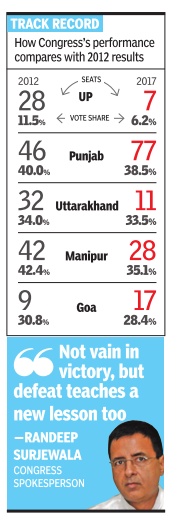
See graphic. 'Performance in state assembly elections, 2012-17'
Religion
2018: Temple Run in MP, After Gujarat Karnataka
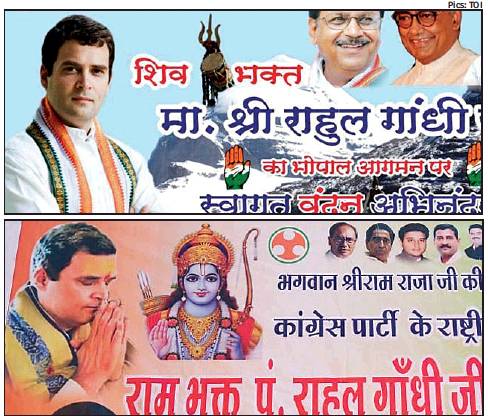
From: Suchandana Gupta , U-turn in 15 yrs: Triple whammy drives Cong into ‘bhakt’ avatar, October 10, 2018: The Times of India
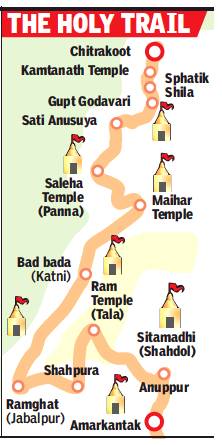
From: Suchandana Gupta , U-turn in 15 yrs: Triple whammy drives Cong into ‘bhakt’ avatar, October 10, 2018: The Times of India
After Gujarat & K’taka, Time For MP Temple Run
Out of power for three terms, the Congress in Madhya Pradesh has taken a complete U-turn in its election strategy for 2018 — from resisting Hindutva in 2003 to embracing it in 2018.
Fifteen years ago, under Digvijaya Singh, the party had brought Habib Tanveer to stage ‘Ponga Pandit’ throughout the state. Now, Congress is projecting Rahul Gandhi as ‘Shivbhakt’, ‘Ram Bhakt’ and even ‘Narmada Bhakt’.
In 2003, Digvijaya’s ‘Ponga Pundit’ tour was meant to counter BJP, which was taking religious sentimentalism to a crescendo, raising issues of alleged cow slaughter in Vidisha and staking claim to a mosque in Dhar as an ancient Hindu structure.
Congress stuck with its projection of secularism even as BJP announced saffron-clad Uma Bharati as its chief ministerial candidate. Digvijaya resisted any saffronisation of the party unit even as VHP called in Narendra Modi and Praveen Togadia to address public meetings. The strategy did not change much in 2008 or in 2013, when the Modi wave swept the nation.
But three defeats and 15 years later, Congress is suddenly seen in different robes. Rahul is projected as ‘Shivbhakt’ on posters after his pilgrimage to Mansarovar, and ‘Ram Bhakt’ when he is in Chitrakoot. In Jabalpur, he was portrayed as a devotee of Ma Narmada. Even during the Gujarat, Uttar Pradesh and Karnataka elections, the AICC chief was seen temple-hopping — and the party garnered votes wherever he was seen standing with folded hands before deities.
The battle for Madhya Pradesh is more intense, so is Congress’ newly acquired saffron streak. The party promises cow protection, a gau shala in every panchayat and stunned BJP with its announcement of Ram Van Gaman Path Yatra — retracing Lord Ram’s exile in MP. Congress posters show Rahul as a “pandit”, just like his great-grandfather Jawaharlal Nehru.
Rahul’s official campaign started after offering puja at Kamtanath temple in Chitrakoot, where it is believed that Lord Rama spent 11 of his 14 years in exile. A Congress delegation under Harishankar Shukla along with sadhus is presently tracking the route Lord Rama took from Chitrakoot to Amarkantak.
Congress has promised to develop MP into a “religious hub” if voted to power. Kamal Nath said, “BJP uses religion only for political gain but Congress will truly develop the state into a religious tourism hub.”
A senior leader in the state Congress said, “In the last five years, Rahul Gandhi has learnt to answer in BJP’s language. He is actively countering BJP’s Hindutva agenda with more Hindutva. No one can now say he is anti-Hindu. He is strategically attacking Prime Minister Narendra Modi not only on issues of corruption, inflation, unemployment but also on Hindutva.” BJP claims it is unaffected by Congress’ saffronisation. BJP national vicepresident Prabhat Jha took swipe at Rahul, saying, “It is BJP’s credit that Rahul Gandhi has turned a Hindu. He knows now that without support of the majority community, Congress cannot win elections. This is not a threat for us, we are amused. Where is secularism of Congress now? Why has that taken a back seat?”
Jha advised Congress to “do some homework on Hinduism”. “In Jabalpur, the AICC president was participating in Narmada aarti in the afternoon. Congress should have known that aarti is done after sunset. We may not see God everywhere but the Almighty is omnipresent. Maa Narmada knows this was Congress’ chunavi aarti (electoral aarti),” Jha said.

